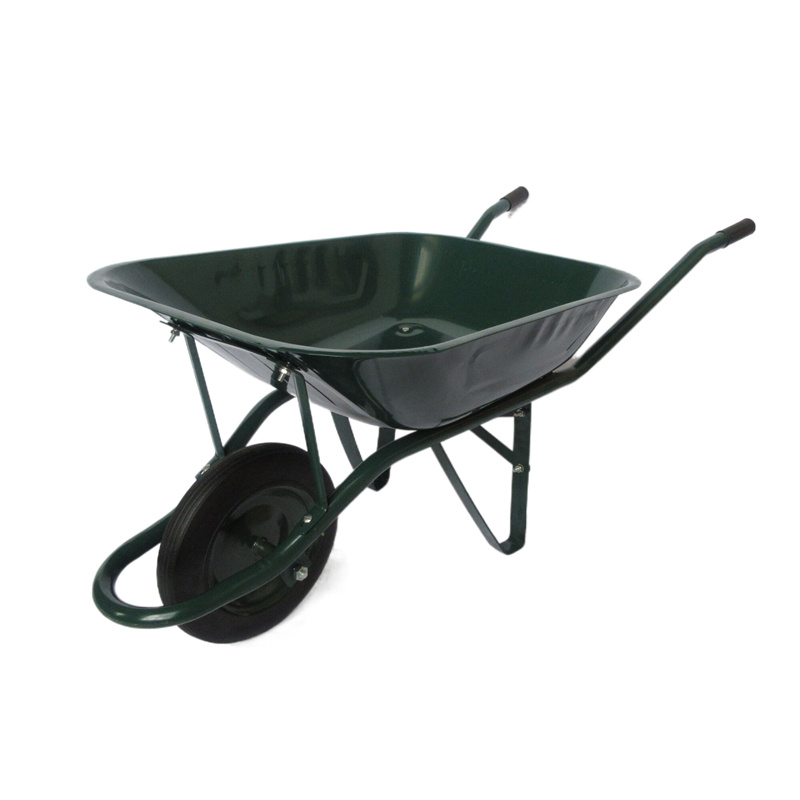- All
- Product Name
- Product Keyword
- Product Model
- Product Summary
- Product Description
- Multi Field Search
Please Choose Your Language
Views: 194 Author: Site Editor Publish Time: 2025-05-19 Origin: Site









When it comes to wheelbarrows, material selection isn’t just a matter of aesthetics or cost—it’s a critical factor that influences performance, durability, and user experience. Whether used in construction sites, home gardening, or agriculture, the materials that make up a wheelbarrow determine how it performs under different loads, weathers various environments, and lasts through years of use. So, what are the best materials for building a wheelbarrow? This article delves deep into the types of materials typically used and evaluates them based on their strengths, weaknesses, and ideal applications.
Steel has long been the go-to material for wheelbarrow frames and trays, especially in industrial or construction environments. It is valued for its strength and structural integrity, making it ideal for carrying heavy loads such as bricks, rocks, and wet concrete.
Steel's rigidity allows for minimal flex under pressure, ensuring stability even when overloaded. It's also highly resistant to punctures and mechanical stress, making it ideal for rough terrain and demanding tasks.
However, steel is heavy. This weight can be a drawback for users who require agility or for tasks that involve a lot of lifting and maneuvering. Another significant concern is rust. Unless treated with anti-corrosion coatings or galvanized, steel will rust when exposed to moisture over time.
Heavy-duty construction, masonry work, and environments where impact resistance is more critical than portability.

Plastic, specifically high-density polyethylene (HDPE), is commonly used in modern wheelbarrow trays. These materials are incredibly popular among homeowners, landscapers, and casual users.
Plastic is significantly lighter than steel, which makes the wheelbarrow easier to push, especially when full. It also doesn't rust, crack under UV exposure, or suffer from chemical corrosion. Additionally, HDPE can withstand a surprising amount of weight without breaking.
While strong, plastic is not indestructible. Under extreme cold, it can become brittle. It’s also not the best choice for sharp or extremely heavy materials like jagged rocks or rebar, which could puncture the tray over time.
Gardening, household tasks, and light landscaping where ease of use and rust resistance matter most.
Although rarely seen in modern commercial wheelbarrows, wood still has a place in traditional or customized models. Historical wheelbarrows and decorative carts often feature wooden trays and frames.
Wood provides a rustic aesthetic and can be quite sturdy if hardwoods like oak or ash are used. When properly sealed, wood resists rot and can endure light to moderate loads.
It’s more susceptible to moisture damage, termites, and splintering. Wood also tends to be heavier than plastic and less durable than steel when handling sharp or extremely heavy items.
Decorative garden carts, light-duty utility in dry environments, or restoration projects.
Aluminum offers a unique balance of being both lightweight and corrosion-resistant. For users who need something between the strength of steel and the lightness of plastic, aluminum is often a top contender.
It’s naturally resistant to rust, which makes it perfect for wet environments or long-term outdoor storage. While not as strong as steel, it is more than sufficient for most household and professional applications. Additionally, it doesn't require frequent maintenance.
Aluminum can be more expensive than other materials. It may also deform more easily under extreme stress or impact compared to steel.
All-purpose wheelbarrows that require frequent movement, exposure to outdoor elements, and moderate load handling.

With advances in material science, composite materials are making their way into wheelbarrow manufacturing. These include fiberglass-reinforced plastics and other engineered polymers.
They combine the best of all worlds: strength, flexibility, and resistance to weather, corrosion, and UV damage. Some high-end composite trays can even outperform steel in terms of impact resistance and durability, all while being much lighter.
The biggest drawback is cost. Composites can be significantly more expensive than plastic or even aluminum. Moreover, they are not as easily recyclable, which may raise environmental concerns.
High-performance wheelbarrows for professionals in landscaping, agriculture, or specialized industrial tasks.
| Material | Weight | Rust Resistance | Load Capacity | Cost | Ideal Use |
|---|---|---|---|---|---|
| Steel | Heavy | Low (unless coated) | Very High | Moderate | Construction, masonry |
| Plastic (HDPE) | Light | High | Moderate | Low | Gardening, home use |
| Wood | Moderate | Low | Low to Moderate | Moderate | Decorative or light-duty tasks |
| Aluminum | Light | Very High | Moderate to High | High | Outdoor, multi-purpose |
| Composite | Light | Very High | High | Very High | Professional landscaping/agriculture |
Aluminum and composite materials typically last the longest outdoors due to their high resistance to rust, UV damage, and corrosion. Steel can last long too, but only if it’s galvanized or regularly maintained.
Not ideal. While plastic is surprisingly strong for its weight, it's not recommended for heavy-duty construction work where impact resistance and load capacity are critical.
It depends on the material. Plastic, aluminum, and composites are safe in the rain. Steel and wood, however, should be stored in a dry place unless properly coated or treated.
If you’re looking for a balance between strength, weight, and resistance to the elements, aluminum is your best all-around option. For heavy-duty tasks, go with steel; for lightweight convenience, plastic is best.
Choosing the best material for building a wheelbarrow boils down to understanding your specific needs. Are you hauling cement across rocky terrain or spreading mulch in your flower bed? A steel tray will take more abuse, but plastic will save your back. Aluminum offers a good middle ground, while composites lead in innovation and performance.
By knowing the strengths and limitations of each material, you can select the right wheelbarrow that fits both your job and your environment—ultimately saving you time, effort, and money in the long run.